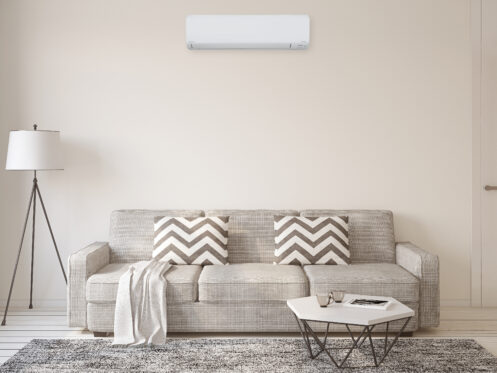Although you may not realize it, ductless mini-split HVAC systems dominate the global HVAC market. They’re the most popular option in almost every developed country, with the U.S. slowly jumping on board. It would make sense, then, that the top manufacturer of mini-splits isn’t an American company. It’s Mitsubishi Electric, a Japanese firm with decades of experience with these systems. Here’s everything you need to know about Mitsubishi ductless systems and why they’re superior to the competition in Metuchen, NJ.
The History of Mitsubishi Ductless Mini-Splits
To understand why Mitsubishi is the ductless mini-split champion, you need to go back to the late 1950s. That’s when ductless mini-split HVAC systems first hit the market. It was a comfort invention born of necessity in post-war Japan. In the aftermath of the war, overcrowding in Japan’s cities led to densely packed neighborhoods. Since money was scarce, homes had thin walls and often had tight clearances between them. Electricity also came at a premium.
As a result of those factors, conventional central HVAC systems brought to Japan by American companies were a poor fit. They were too loud, too large, and required ductwork that Japanese homes had no room for. To solve those problems, Mitsubishi Electric went to work on a modular, compact type of HVAC system. In 1959, their engineers succeeded, and the ductless mini-split as we know it today was born. The advantages of Mitsubishi’s invention were immediately clear. The mini-split was small, quiet, and extremely efficient.
The Advantages of Mitsubishi’s Ductless Mini-Splits
Since Mitsubishi is the inventor of mini-split technology, they’ve been refining their invention for longer than anyone else. As a result, today’s Mitsubishi mini-split HVAC systems offer advantages you don’t get with other brands. They include the following:
High Energy Efficiency
One of the most important advantages offered by Mitsubishi mini-splits is their high energy efficiency. Mitsubishi was an early technology innovator, adding key technologies like inverter-driven motors to improve efficiency. Inverter-driven motors use control circuitry and electromagnets to allow for variable-speed operation. In a mini-split, the technology allows the system to speed up and slow down its compressor and fans. That mode of operation lets the mini-split use only the exact amount of energy needed to meet demand. In effect, this scales the system’s capacity up and down based on your heating and cooling needs.
Quiet Operation
Mitsubishi mini-splits also have a reputation for being among the quietest HVAC systems available. The average Mitsubishi mini-split’s outdoor unit produces approximately 48 dB while running at full capacity. That’s quieter than the noise you’d hear during moderate rainfall. As a result, you’d need to be right near a Mitsubishi mini-split’s outdoor unit to notice it running. That makes them perfect for the kinds of tight spaces that led to the mini-split’s invention.
The indoor air handlers of Mitsubishi mini-split HVAC systems are also among the quietest available. On average, they produce about 32 dB while running, which is barely louder than the background noise at the library. That’s not all, though. Many of Mitsubishi’s flagship mini-split models feature a special quiet mode. This mode lowers fan speeds enough to make the systems with the feature almost silent while running. The mode does lower operating efficiency, but it’s a useful feature for those who prioritize peace and quiet.
Excellent Low-Temperature Performance
Another advantage you can get from a Mitsubishi ductless mini-split is unbeatable performance at low temperatures. A big drawback of using the typical mini-split as a heat source is that it’s notorious for poor cold-weather performance. Mitsubishi, however, overcame those limitations with its Hyper-Heat H2i technology. The technology allows H2i-equipped systems to work efficiently down to about -13 degrees Fahrenheit. They accomplish this in a few ways. For one, they use next-generation refrigerants that work in a wider range of temperature conditions. Another is the use of a patented flash-injection refrigerant system. This lets a Mitsubishi mini-split extract the maximum amount of heat energy from its refrigerant. To do it, a bypass valve redirects still-warm refrigerant back inside your home while the outdoor unit collects more heat. Plus, it offers hot start capabilities, which eliminate the burst of cold air most other mini-splits produce when activated.
3D i-See Sensor Technology
Some Mitsubishi mini-split HVAC system models also include exclusive 3D i-See sensor technology. This allows the systems’ indoor units to offer functionality you can’t get elsewhere. For example, you can use it to ensure that your air handlers always direct their airflow to your location. The sensors can also scan rooms to detect hot and cold spots. That allows them to direct airflow to ensure even comfort in every part of your home. The sensors can even detect your presence or absence in a room. That enables the air handlers to adjust temperatures automatically for maximum energy savings.
Superior Air Filtration Technology
Mitsubishi mini-split HVAC systems also offer some of the best air filtration options you can find on a mini-split. Depending on the mini-split model you choose, it may work with one of two specialized types of air filters. One is called a catechin filter. They make clever use of a bioflavonoid found in green tea to improve your indoor air quality. Catechin has natural antiviral and antibacterial properties and captures odor-causing pollutants. Plus, catechin filters are washable and can last for up to 10 years before needing replacement.
The other type of air filtration offered by Mitsubishi mini-splits is called platinum deodorizing filtration. They include a platinum-infused catalyst that attracts and traps contaminants and odors. Amazingly, the filters operate at a nanometer scale, which means they can capture even the smallest pollutants in your air. Plus, the filters are long-lasting and rarely require replacement.
Extended Lifespan
Mitsubishi mini-splits also have a reputation for durability. While the average mini-split may only last for 10 to 15 years, Mitsubishi systems routinely last for up to 20. That makes them an excellent comfort investment compared to the competition. Mitsubishi systems should also require fewer repairs during their lifespan compared to the competition. Overall, this reduces the total cost of ownership of a Mitsubishi mini-split HVAC and justifies their slightly higher upfront costs.
Local Mitsubishi Mini-Split Experts
If you’re looking for a ductless mini-split for your Metuchen home, Sam's Air Control can help. As a Mitsubishi Electric Diamond Contractor, we sell and install the finest mini-splits on the market. We’re also specially qualified to install your new mini-split to Mitsubishi’s exacting specifications. On top of that, all our HVAC technicians are NATE-certified. That means they can handle all your HVAC needs with ease.
We offer HVAC installation, maintenance, and repair services, as well as boilers, ductwork, geothermal, and commercial HVAC services. We also offer financing options on approved credit to help you afford the new Mitsubishi mini-split you need. We can even help you take advantage of statewide HVAC rebate programs and those offered by utility providers. If you want a Mitsubishi ductless mini-split installed in Metuchen, contact Sam's Air Control today!


